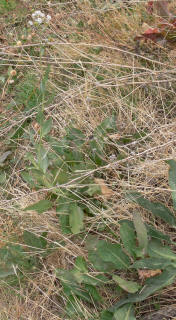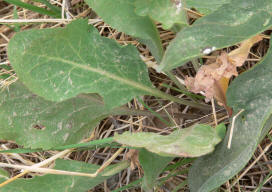|
INVASIVE SPECIES ERADICATION
Staff and volunteers of the
Kern River Preserve have spent over a decade
fighting invasive species. These efforts have
paid off with one of the most native forests in
western North America.
For many years
staff of the Kern River Preserve and partners
have spent
thousands of hours attempting to eradicate
purple loosestrife and perennial pepperweed from
South Fork Valley
lands.
Each of us can help prevent
the spread of invasive plants and animals. You
can help by learning which species can become
invasive and eradicate these from your own
yards. Help to educate your local nurseries
about the problem with invasives and get them to
stop selling problem plants. Contact your
legislator and local agriculture commissioner to
make sure no invasives are sold or promoted in
your county or town.
The article that follows is a
tutorial on perennial pepperweed: one of a
series of articles staff of the Kern River
Preserve are preparing to educate about local
invasives and some steps each of us can take to
help eradicate them.
 PERENNIAL
PEPPERWEED PERENNIAL
PEPPERWEED
(Lepidium
latifolium), from bank to bank and
shore to shore, this noxious newcomer to the
South Fork is native to southern Europe and
western Asia. It spreads by mostly by creeping
roots and seed under many different
environmental conditions.
This perennial plant has glabrous (hairless)
bright green to gray-green leaves. It is
distinguished from the another invasive hoary
cress or whitetop (Lepidium draba) by the
stalked leaves that do not clasp the stem like
the cress. Rosette leaves are ovate to oblong
with entire to serrate margins on long petioles.
Rosette leaves are about 4 to 11 inches long and
1 to 3 inches wide. Stem leaves are sessile and
lanceolate, have entire to toothed margins, and
become smaller toward the top of the stem.
The plant grows up to six
feet tall forming dense thickets that crowd out
native plants. Mature plants have numerous
erect, semi-woody stems that originate from
large, interconnected roots. Roots are long,
minimally branched, and enlarged at the soil
surface forming a semi-woody crown. It normally
flowers in summer but as with most plants in the
mustard family can flower at any time conditions
are right. The flowers are small white and form
dense clusters at the end of the branches. The
fruit (seed housing) is a two seeded, reddish
brown, slightly hairy, 1/16" long capsule.

Native to southern Europe and
western Asia, it grows in waste areas, wet
areas, ditches, roadsides, cropland, along
waterways, and dry habitats such as road cuts
and fills. Robust, deep-seated spreading roots
and numerous seeds make this weed very difficult
to control. Past attempts at mechanical removal
have actually caused the spread of the plant and
an increase in numbers.
Recent surveys identify
perennial pepperweed as a weed problem in nearly
all of California, and both the California
Department of Food and Agriculture (CDFA) and
California Invasive Plant Council (Cal-IPC) list
it as a noxious weed of greatest ecological
concern. Small to moderate infestations of
perennial pepperweed are found along the South
Fork Kern River from Tulare to Kern County, and
large infestations are found along the Susan
River (Lassen County), the Lower Klamath
Wildlife Refuge (Siskiyou County) and the
Truckee River (Washoe County, Nevada) Scattered
infestations occur along the Sacramento River
north of Lake Shasta (Shasta County), as well as
along roadways in Lassen County and Washoe
County, Nevada.
MANAGEMENT IN HOME LANDSCAPES
Prevention is the best
management strategy for avoiding problems with
perennial pepperweed in and around home
landscapes. If perennial pepperweed is found
growing in landscaped areas, immediately control
the plant before it can spread. Pulling plants
(try to remove as much of the root as possible)
is an effective way of controlling a few
scattered plants growing within landscaped
areas. Contact a licensed pesticide applicator
if you would like to control any weeds
chemically.
MANAGEMENT IN PASTURES,
RANGELAND, RIGHTS-OF-WAY, AND CROPS
Established perennial
pepperweed populations are difficult to control
and require multiple years of intensive
management. Suppressing the extensive root
system is critical for successful control. A
management program should include prevention,
monitoring, and treatment of small satellite
populations before plants develop extensive
roots. Make sure root fragments and seed are not
transported to other sites. Always clean
vehicles, machinery, and clothing after visiting
infested areas.
|